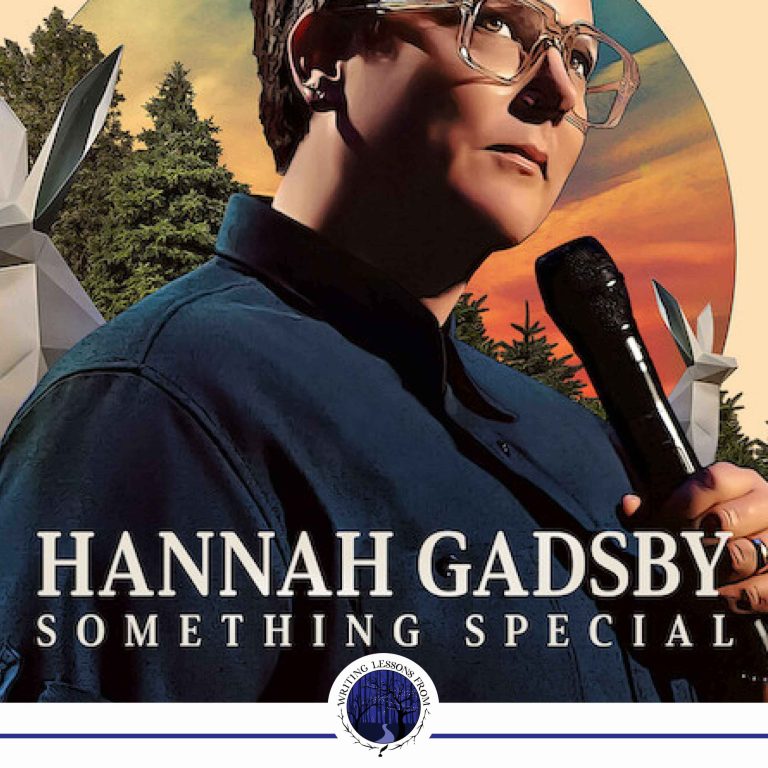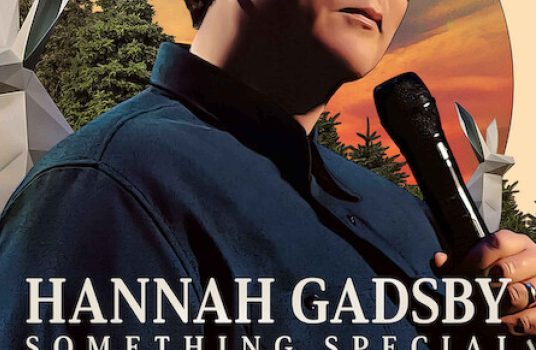Writing Lessons From... Hannah Gadsby's Something Special aka ??
Listen to the blogcast of this episode:
Every Friday I write about the writing lessons I’ve taken from different stories. So far they’ve all been films and TV shows, and they’ve all had something negative about them. So, it’s time for something different.
It’s so much harder to find the writing lessons in something amazingly good. Watching, reading or listening to something that has faults seems easier to dissect, you can figure out what you didn’t like and learn from it. But when something is good, the talent and sheer magic of the storytelling make it hard to find the cracks that allow you to figure out why you loved it, why it made you feel so good, and apply those lessons to your own writing.
Still, we’re going to try here.
Something Special is a comedy special by Hannah Gadsby, an Australian comedian known for their ground-breaking comedy special Nanette, which I haven’t watched yet.
Seriously, if you’re a comedy fan, go and watch Something Special by Hannah Gadsby before you read on. From here, there be spoilers.
(Hannah Gadsby: Something Special is available on Netflix.)

It’s not often these days that I watch something that makes me want to punch the air by the end, or that makes me exclaim out loud JUST how good it was. It’s even less likely that a comedy special will make me do this.
But that’s exactly what Hannah Gadsby’s special Something Special did.
The end made me realise just how genius the storytelling was, and I’ve been trying to work out how they did it ever since.
Something Special is the story of how Hannah Gadsby proposed to their wife. It’s hilarious and takes us on a journey.
The whole thing is also a story about telling a story. The story of a proposal, broken down, because it’s not your average proposal story and it’s not one that the ‘gatekeepers’ might consider romantic.
After so much thought, I can narrow down why I think this writing is so good to:
Hannah is a natural (professional!), talented storyteller
The storytelling is made up of layers and sowing seeds, which is a lesson that can be used directly in your novel, screenplay, or even non-fiction. Or, you know, a comedy special.
Layers and seeds might be the same thing
Although Hannah starts by telling us that this is the story of how they proposed to their wife, and even gives us the ending, they then seem to go off into a tangent about other things.
Such as how their father tells a ‘story’ by stating facts, about their previous toxic relationship that involved hitting a rabbit with a car, their autism diagnosis, a description of netball…
You might be convinced that none of this has anything to do with the proposal, or even their relationship and marriage. Until the end, when all of those seeds and layers come together in beautiful, magical moments.
The bunny, especially, is particularly key, and particularly gruesome. It isn’t at all romantic. Until it is. In a weird way.
My favourite moment is near the beginning when Hannah explains that their father tells stories by listing facts, then later we discover that Hannah’s wife also tells stories this way. It’s an utterly heart-warming moment filled with joy, a sign of how perfect a couple they are. It could only possibly be this heart-warming because Hannah had laid the groundwork, explaining their parents’ relationship, allowing the audience to draw the inevitable conclusion later on.
Almost every little detail Hannah gave in the first half of the show comes back towards the end, creating a little romance, making more sense, giving closure, giving the audience that ‘oh!’ moment.
Every tangent is there for a reason.
This is something that was taught on a recent screenwriting course I completed, and something that you often see in crime fiction. Everything should serve a purpose. You show it near the beginning and make the reader or audience aware of it. There’s then a sense of fulfilment and closure when it comes into use later in the story, or in the case of crime fiction, happens to be a red herring.
Something Special, however, tells us that we can show the reader or audience a thing, but not necessarily make it obvious that it will come into use later in the story. That’s what made Something Special so magical – just how everything joined up beautifully, how it all linked together when you might not have been expecting it.
Although I wonder how much of this you could get away with in a novel, written story or screenplay. Maybe this is just a comedy feature.
Do comedy specials have subplots?
There are subplots in Something Special. I guess that’s what all these seeds are – how Hannah’s father only ever shouted once at the dog when he dropped some cheese, which seemingly has nothing to do with anything until the end.
Although there are some subplots (jokes!) that have nothing to do with the main story, such as the repeated joke of why Hannah doesn’t sleep with men, none of which make sense but every single one is funny.
The lesson there is maybe that we are allowed to include little, supposedly pointless subplots or tangents, but only if they’re fun. Depending on what you’re creating and the genre, and if done with care (don’t make them too long or distracting – the short stories included in Stephen King’s novella The Body is an example of this).
The last lesson on romance…
Ultimately, Something Special is a love story. Not only does Hannah tell us how they proposed to their wife, but also how they met and a little of what came before. What came before was pain and fear, in the midst was an autism diagnosis that lifted a veil of confusion, and what came during the proposal was fear and gore, alongside a global pandemic.
Something Special taught me that in an ideal world, and certain fictional worlds, romance doesn’t have to be classically romantic.
If you’re not writing in the romance genre, where a certain structure is expected, Something Special suggests that you could write a drama, a fantasy, a sci-fi, a comedy special that is a romance without the usual romantic structure. Because even with some gore and fear and pain, a romance can still leave you filled with love and joy.
It’s like permission to play with the concept, and that’s hugely freeing.
Something Special also shows the importance of a full story. Hannah tells us at the beginning how they proposed to their wife.
’Who do you want to be?’
’Your wife.’
It’s cute, it’s sweet. But when Hannah repeats this ending after telling the whole story, it packs so much more of a punch. Those two words, ‘Your wife,’ make you smile, fill you with joy, bring a tear to the eye.
And that’s the power of great storytelling, but also of telling the full story.
To sum up…
The lessons I’ve taken from Something Special about how to tell such a wonderfully compelling story are simple: lay the groundwork and sow the seeds, show your audience/readers interesting things which will come full circle and be important later, and you have permission to be playful. Still be professional, try and do it cleverly, but have fun and be playful with the concepts and ideas.
Writing and storytelling should be fun, both for you and your audience. Add in details, go off on tangents (carefully), tell the full story.
Don’t over-explain those seeds and details, credit your audience with some intelligence, and take them on a journey with you.


